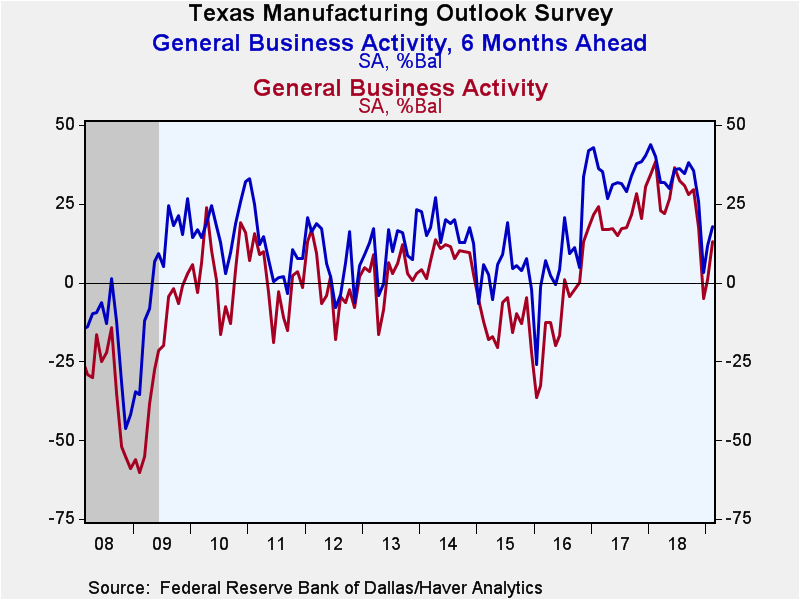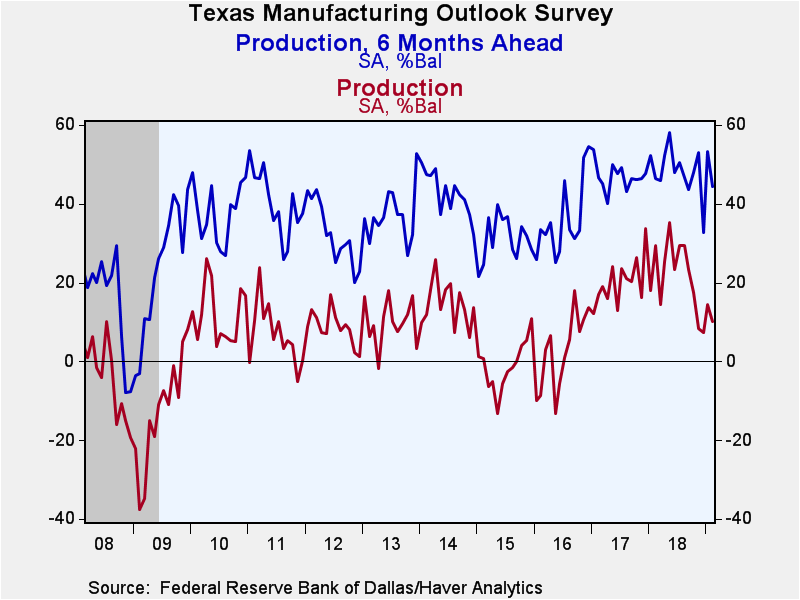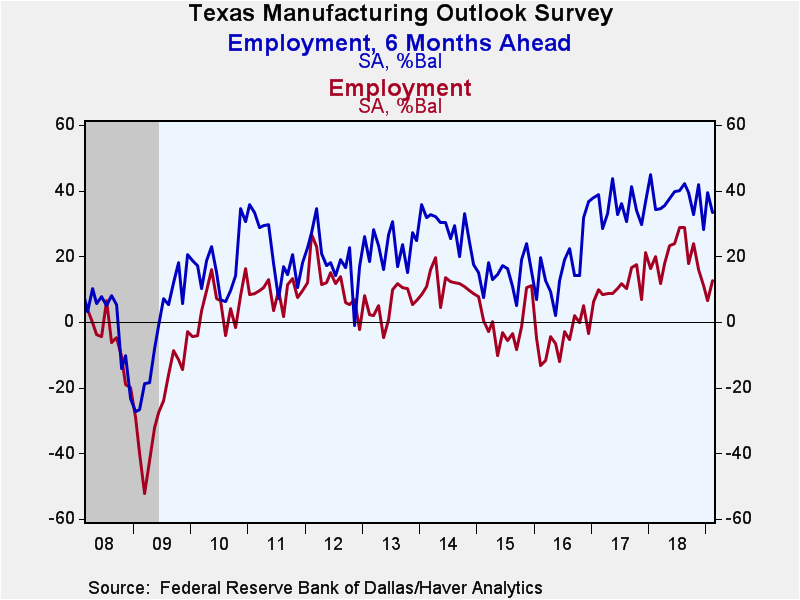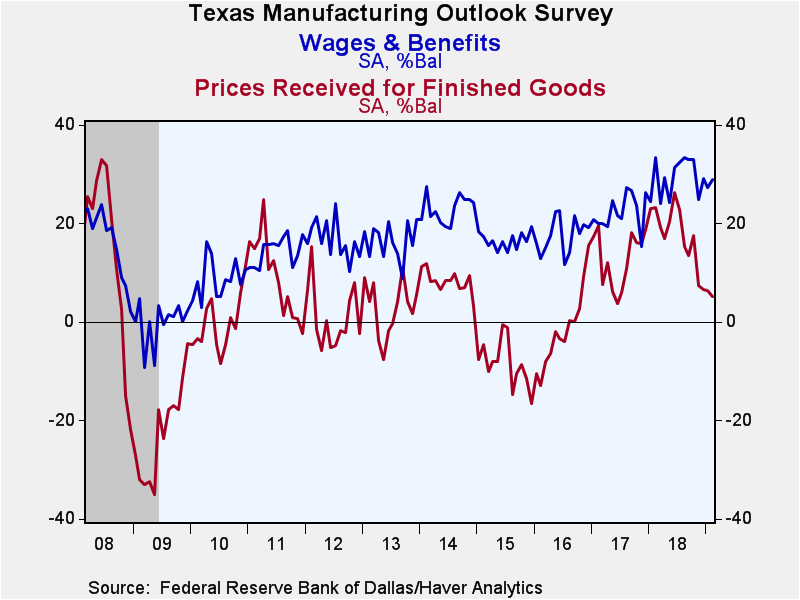 Global| Feb 25 2019
Global| Feb 25 2019Texas Factory Sector Outlook Continues to Improve
Summary
The Federal Reserve Bank of Dallas reported in its Texas Manufacturing Outlook Survey that the General Business Activity Index jumped to 13.1 in February from 1.0 in January. The index had fallen to a two-and-a-half year low of -5.1 [...]
The Federal Reserve Bank of Dallas reported in its Texas Manufacturing Outlook Survey that the General Business Activity Index jumped to 13.1 in February from 1.0 in January. The index had fallen to a two-and-a-half year low of -5.1 in December 2018.
Individual measures of activity were mixed. The production index declined to 10.1 from 14.5 and shipments decreased to 10.7 from 11.4. Still, these measures were above their December readings. Meanwhile, the growth rate of orders, employment and wages & benefits rose. The index for finished goods prices received continued its slide, falling to its lowest level in 18 months. Since June 2018 the prices received index has fallen by 21 percentage points.
The index of expected business conditions in six months continued its rebound from its December low. However, expected production, growth in orders, employment, wages, and capital spending measures declined. Expected shipments and the amount of unfilled orders increased.
Each index is calculated by subtracting the percentage reporting a decrease from the percentage reporting an increase. When all firms report rising activity, an index will register 100. An index will register -100 when all firms report a decrease. An index will be zero when the number of firms reporting an increase or decrease is equal. Items may not add up to 100% because of rounding. Data for the Texas Manufacturing Outlook can be found in Haver's SURVEYS database.
| Texas Manufacturing Outlook Survey (SA, % Balance) | Feb | Jan | Dec | Feb'17 | 2018 | 2017 | 2016 |
|---|---|---|---|---|---|---|---|
| Current General Business Activity Index | 13.1 | 1.0 | -5.1 | 38.4 | 26.2 | 20.6 | -8.9 |
| Production | 10.1 | 14.5 | 7.3 | 29.5 | 21.8 | 20.2 | 2.4 |
| Growth Rate of New Orders | 3.4 | 1.2 | 5.8 | 17.0 | 14.8 | 11.4 | -7.3 |
| Employment | 12.6 | 6.6 | 11.0 | 20.0 | 19.9 | 11.4 | -4.9 |
| Wages & Benefits | 28.9 | 27.4 | 29.2 | 33.4 | 29.4 | 22.2 | 17.6 |
| Prices Received for Finished Goods | 5.2 | 6.4 | 6.6 | 23.3 | 17.7 | 12.7 | -1.6 |
| General Business Activity Index Expected in Six Months | 17.7 | 11.7 | 3.2 | 40.0 | 32.2 | 34.6 | 8.9 |
| Production | 44.3 | 53.4 | 32.7 | 46.5 | 48.1 | 46.8 | 35.8 |
| Growth Rate of New Orders | 30.8 | 38.5 | 23.1 | 37.1 | 35.7 | 37.7 | 24.3 |
| Employment | 33.2 | 39.4 | 28.2 | 34.3 | 37.6 | 35.2 | 16.8 |
| Wages & Benefits | 47.0 | 47.7 | 45.0 | 49.4 | 50.5 | 43.4 | 34.8 |
Gerald D. Cohen
AuthorMore in Author Profile »Gerald Cohen provides strategic vision and leadership of the translational economic research and policy initiatives at the Kenan Institute of Private Enterprise.
He has worked in both the public and private sectors focusing on the intersection between financial markets and economic fundamentals. He was a Senior Economist at Haver Analytics from January 2019 to February 2021. During the Obama Administration Gerald was Deputy Assistant Secretary for Macroeconomic Analysis at the U.S. Department of Treasury where he helped formulate and evaluate the impact of policy proposals on the U.S. economy. Prior to Treasury, he co-managed a global macro fund at Ziff Brothers Investments.
Gerald holds a bachelor’s of science from the Massachusetts Institute of Technology and a Ph.D. in Economics from Harvard University and is a contributing author to 30-Second Money as well as a co-author of Political Cycles and the Macroeconomy.









